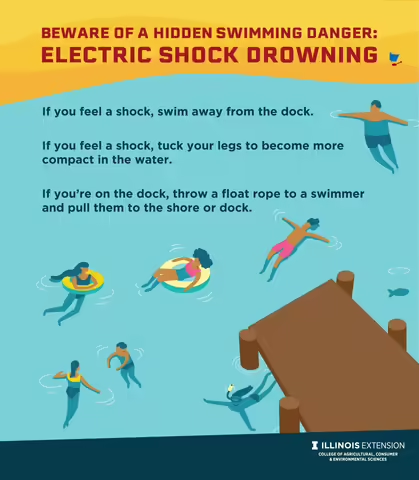SPRINGFIELD, Ill. - Before taking the plunge, know what could be lurking in the water. As temperatures rise outside and the cooling water beckons, look for signs of a hidden electric shock danger in lakes and other water sources.
Electric shock drowning (ESD) happens when electrical current leaks into water from a nearby electrical source, such as a yacht, boat, or marina dock. “As a child or adult swims in or near water that is electrified, his or her body can become a conductor for that electricity," says Erin Hollinshead, executive director of Safe Electricity, University of Illinois Extension. “Once that electricity moves through the body, a person may become paralyzed and drown.”
People recognize the dangers of using electrical devices in a sink of water or flooded basement, but may not realize unknown dangers exist in bodies of water. How does electricity sometimes escape into the water? "Outdated wiring and a lack of proper safety equipment on boats and docks can cause it to happen," Hollinshead says. "While ESD is an invisible danger, knowing how to prevent it or respond if you believe you're in danger can save your life or the life of someone else.”
Safe Electricity offers these safety tips to recognize and avoid electric shock drowning:
While swimming:
- Do not swim around docks with electrical service or boats that are plugged into shore-to-dock power.
- "If you feel a shock, swim away from the dock," helps you remember what to do if you feel tingling or shocks. Yell to others to cut the power source.
- If you think you are swimming in water that could be electrified, try to stay upright, tuck your legs up so that you are more compact, and swim away from anything you think could be energizing the water.
When helping someone else:
- Do not jump in to try to save someone you suspect might be exposed to electricity in the water. Instead, throw a float and turn off shore power by using a switch or other mechanism (usually found on the meter base) or unplugging the shore power cords.
- Eliminate the source of power first, then call 9-1-1.
- Use a float rope to pull the person to the shore or dock. If you cannot find a pulse, perform CPR until emergency responders arrive.
Prevention and Maintenance:
- If you own a boat that has an electrical system, make sure it is in good working order and have it inspected annually by a qualified electrician versed on marine codes and standards. In addition, consider purchasing a clamp meter to test for stray electricity.
- All docks should have ground fault circuit interrupters (GFCIs) installed on circuits feeding electricity to the docks. A GFCI detects problems along the electrical path, such as a discharge into the water, and cuts the power. Test it monthly to ensure proper operation.
- Check hot tubs, pools, and water parks for faulty electronics. Get out of the water if you feel tingling or unusual sensations.
While it is impossible to know if water is electrified just by looking, learning about the dangers of ESD can help keep you safe in the water. For more information about safety around electricity, visit SafeElectricity.org.
Source: Erin Hollinshead, Executive Director, Safe Electricity
Writer: Ann Augspurger, Communications Director, Safe Electricity
Safe Electricity is the award-winning, public awareness program of the Energy Education Council, a 501(c) 3 (not-for-profit organization) established in 1952 on the campus of the University of Illinois at Urbana-Champaign. With offices located in Springfield, Ill., Safe Electricity operates under the University of Illinois Extension and is led by the EEC Board of Directors. Since the Safe Electricity program was created in 2001, it has provided thousands safety-minded resources to its more than 500 utility members from across the country to help save lives and reduce injuries.
